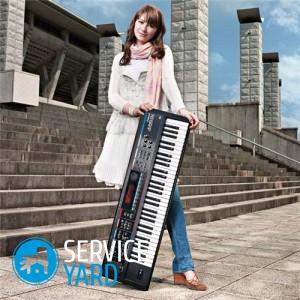How to choose a synthesizer?

Modern musical instruments make even a beginner feel like a professional. A rich deep sound, a variety of rhythms, the ability to make an interesting arrangement with a minimum of effort - this is not a complete list of what the synthesizer allows. But how to choose a synthesizer? “We will discuss this now.”
to contents ↑Why do you need it?
Before heading to the music store, try to answer yourself two questions:
- Why do you need a synthesizer?
- Who will play on it?
If you know the answers exactly, it will be easier for you to deal with this magnificence of keys, buttons and levers.
So, synthesizers are:
- for beginners;
- semi-professional;
- professional;
- midi keyboards.
In addition to the number of functions, synthesizers have two types of keyboards:
- active;
- passive.
Important! Distinguishing them is simple. If the keyboard is passive, the strength of the sound does not depend on the keystroke. An active keyboard provides much more features, but also requires certain skills.
There is a separate group of toy synthesizers, but they are only suitable for preschool children and are sold not in music stores, but in toy stores. They are not suitable for study or home music.
to contents ↑Important! Even if the child will learn, buy immediately a synthesizer with a standard keyboard, with keys the same size as the piano.
Synthesizer for beginners
These are the simplest and cheapest synthesizers, with a minimum of functions. This can be used for home music playing - it has much more functions than the piano, and it takes up much less space. In addition, it is easy to transport.
The synthesizer for a novice musician is most often small. But his range is small - a maximum of four and a half octaves. Naturally, the number of keys is also small, usually there are not more than fifty of them.
Keyboard, features, price
Synthesizers for novice musicians usually have a passive keyboard. Such a device most often does not have recording functions, but it always has connectors that allow you to connect it to a computer and use it as a MIDI keyboard.
Important! A good music editor will make it possible to significantly expand the functionality of the device - in the hands of a professional, even a simple synthesizer behaves like a professional.
The number of functions the synthesizer has for beginners is limited, but it helps to master the basics of musical art - to learn notes and chords, to put a hand on.
to contents ↑Important! As for the price line, such tools are at its beginning - they are about two times more expensive than toy synthesizers, but much cheaper than professional ones.
Semi-Professional Synthesizer
If the question of how to choose a synthesizer for a beginner is more or less clear, then with semi-professional models things are not so clear.
How do they differ from a tool for beginners? - The main difference is as follows:
- A more solid range is usually 5 octaves.
- More keys - up to 60 and even more.
Important! A semi-professional device can have both a passive and an active keyboard.
Keyboard
On sale you can find semi-professional models, in which the keyboard is the same as the piano - up to 7 octaves, 88 keys.They are convenient if you are going to play only at home, but it’s already difficult to transfer such instruments.
An active keyboard has its advantages. The strength of the sound depends on the force with which a musician presses a key. In addition, you can change the stiffness of pressing. It happens:
- light
- half-weighted;
- weighted.
to contents ↑Important! In fact, you can play such a synthesizer in the same way as you play a piano, and for this very reason these devices are often bought by young pianists for homework. True, it costs significantly more than a synthesizer for beginners - at least three times. But the price depends not only on the size and type of the keyboard - the number of functions is very important.
Professional synthesizer
The answer to the question of which synthesizer is better for the professional is obvious. He needs a tool that allows you to:
- work on sound;
- experiment with various functions;
- process tunes;
- mix;
- add effects according to the creative concept;
- write down;
- digitize;
- edit your creations.
And for a true musician it is better if all these features are in one box.
Of course, a professional synthesizer can stand at home. He will give some opportunities to a beginner - in any case, it is quite possible to study the basics of performing skills on such an instrument. But only a real pro is ready to use all its features.
to contents ↑Important! Given that the prices of such synthesizers are often cosmic, consider whether this is really what you want. However, you can find models that are close to semi-professional in value.
What to look for?
Very important characteristics are:
- timbre;
- polyphony;
- memory;
- styles
- separation of keyboards on the right and left.
Timbre
The timbre of each instrument “embedded” in a musical device of this type should correspond to its name. A violin should sound like a violin, a pipe like a pipe. Unfortunately, not all manufacturers are able to do this, some have string strings, brass instruments do not, others have the opposite. Try to choose a synthesizer so that each instrument sounds more or less like a real one.
Polyphony
This term in electronic music refers to how many keys can sound simultaneously over a period of time. This feature is indicated in the characteristics and is indicated by numbers:
- If you see the number 4, it means that 4 keys will sound simultaneously, even if you pressed 5, 6 or 8.
- As a rule, the declared standard of semi-professional models is 32. Of course, pressing 32 keys at the same time is not so simple, but the principle of sound generation in modern synthesizers is not the same as in piano. Sound is obtained by the method of wave synthesis, which gives a lot of possibilities.
- Not so long ago, more complex models with 64-bit polyphony appeared. But they are still quite expensive.
Memory
What is the synthesizer memory for? The more memory, the more new sounds you can synthesize, the more samples the instrument remembers, the more opportunities there will be. But the question arises - how much do you personally need?
It is worth starting from this. Of course, professional tools have the largest amount of memory. But those who just want to sing karaoke at a friendly party or improvise a little in their free time, hardly need the same thing as the musician on stage.
Styles
Styles are embedded in almost all models. Even on the simplest instrument, you can play a march, waltz or polka without any effort. The more complex the instrument, the more rhythmic figures are embedded in it.
Important! They are also useful for beginners, since at the first stage of training they play the role of a metronome.
Keyboard
The keyboard can be divided into right and left parts. Each part has its own timbre. Most often this happens with instruments with an active keyboard. And here again the goal is important:
- A person who has replaced a piano with a synthesizer does not need such features, as a beginner, just beginning to understand how sound is extracted.
- But for a person with good technology, such a keyboard gives additional bonuses.
What do you need at home?
So still, how to choose a synthesizer for the home? It’s best to follow the “from simple to complex” principle. This is especially important if you buy such a tool for a child, because it is still unclear whether this activity will take him for a long time. Therefore, it is best to choose a fairly simple tool for which:
- good timbre;
- comfortable keyboard;
- there is a minimum amount of memory;
- the average value of polyphony.
Once you or your child learn the basics, it will be possible to purchase a more sophisticated tool, semi-professional. Will it come to professional? Not necessarily, because even a semi-professional synthesizer, at a lower price, provides very great opportunities.
to contents ↑And what is not worth buying?
The choice in stores, of course, is large, and you will greatly simplify your life if you immediately exclude some tools. Not worth buying:
- interactive synthesizers;
- too old;
- those with only electronic sound;
- non-standard keyboard models.
Why so? - It's simple:
- As for the interactive tools, which sometimes even very reputable companies indulge in, these are just toys, although they are called tools. You can’t learn from them, but you can play only what is laid down there.
- As for the old tools. A synthesizer is not a violin to which years have given nobility. This is an electronic tool, and for electronic devices, even if they are not used, time is the enemy. Tools age not only mentally, but also physically.
- If a musical instrument has only electronic sound, you can play it, of course. But it provides few opportunities even for a beginner.
- As for the keyboard, the standards have been developed for centuries and perfectly match the human hand.
Stock footage
That's all, we figured out different types of synthesizers and now you probably better imagine what kind of musical instrument you should choose for home. So - and the creative process will be more enjoyable for you.
- How to choose a vacuum cleaner taking into account the characteristics of the house and coatings?
- What to look for when choosing a water delivery
- How to quickly create comfort at home - tips for housewives
- How to choose the perfect TV - useful tips
- What to look for when choosing blinds
- What should be running shoes?
- What useful things can you buy in a hardware store
- Iphone 11 pro max review
- Than iPhone is better than Android smartphones



